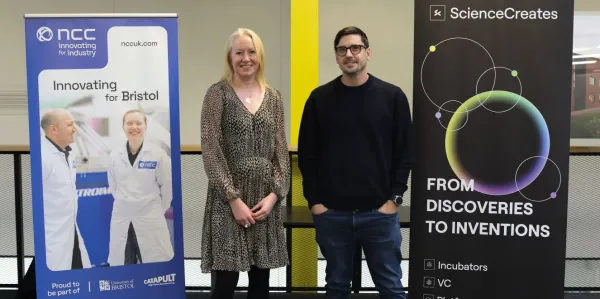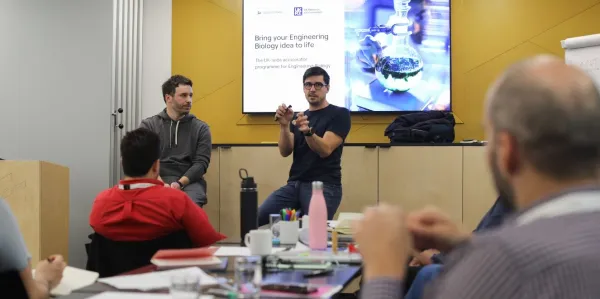Bringing protein sequencing into the 21st Century
Portal Biotech is on a mission to revolutionise how we study proteins — the molecules that drive nearly every function in the human body.

Portal Biotech — The startup unlocking the next big leap in biotechnology

Portal Biotech is on a mission to revolutionise how we study proteins — the molecules that drive nearly every function in the human body.
The startup was formed in 2021 by founders Andy Heron, a scientist with a background in membrane biophysics and nanopore sequencing, and Giovanni Maglia, Professor of Chemical Biology at Groningen University, who has spent the past two decades engineering nanopores. Giovanni and Andy met while working as postdocs in the same research group in the early 2000s.
Before launching Portal Biotech, their work played a key role in developing Oxford Nanopore’s DNA sequencing technology, a spinout from Oxford University that pioneered real-time, portable DNA sequencing.
Now, the Portal Biotech team is applying the same principles to protein sequencing, a scientific challenge that has progressed at a frustratingly slow pace and remained unsolved — until now.
We caught up with Andy in early 2025 to discuss Portal’s rapid journey from pre-seed to Series A as the company prepares to take its technology out of the lab and into the real world.
The next big leap after the Human Genome Project
The early 2000s saw one of the most important races in the history of science. Publicly-funded researchers battled a private company to sequence the entire human genome, a breakthrough that promised to redefine how we study and treat disease. The public project won, and so did medicine: thanks to these new, open-access insights, we developed targeted therapies for once-fatal conditions like certain types of breast cancer and cystic fibrosis; we can now identify people at risk of early-onset Alzheimer’s; and design prevention strategies for cardiovascular and metabolic disease based on genetic risk factors.
But the early days following completion of the Human Genome Project needed to focus on making the DNA sequencing technology more accessible.
"Myself and Giovanni Maglia both overlapped as postdocs in the same research group, leading the projects on nanopore DNA sequencing as part of the NIH's $1,000 Genome Project — which sought to reduce the cost of DNA sequencing from almost $3bn to under $1000, as well as encouraging new approaches to DNA sequencing", Andy explains.
The $1000 Genome Project drove the rise of spinouts like Oxford Nanopore, which revolutionised genomics by making sequencing portable and accessible. Their nanopore-based approach enabled real-time sequencing outside traditional lab environments, from tracking disease outbreaks to space missions.
But while DNA sequencing became routine, understanding proteins — the real workhorses of biology — remained a challenge. Just as the Human Genome Project and the $1000 Genome Project pushed the field of genetics forward, companies like Portal Biotech are now spearheading the advancement of protein sequencing, to bring the same level of accessibility and impact to understanding proteins as we did with DNA two decades ago.
"I left Oxford Nanopore in 2020, just when Covid started. A large part of leaving was that I could see that DNA sequencing was solved. Okay — there's more to do in that space, but there are bigger problems to solve in the next generation. So I was very interested in working out how we could make an impact on the next ten years of the big problems out there in proteomics." He continues: "I connected with Giovanni, who had also set his mind towards solving problems by measuring proteins and small molecules. And he's basically built a career around this."
Understanding and measuring proteins is critical because it’s proteins, not DNA, that determine what’s happening in our bodies right now — and Portal’s technology is on its way to help us paint a detailed picture of that, at scale.
Where DNA informs, proteins perform
DNA alone doesn’t tell the full story — because genes only provide instructions for making proteins.
“DNA sequencing is largely done... but your DNA is not who you are on a day-to-day basis. If you really want to understand your health, your diseases, even things like how you respond to exercise or ageing, the molecules you need to measure are proteins and small molecules", Andy explains.
The 'language' of DNA — four different kinds of nucleotides (A, T, C, G) — is translated into the language of proteins, which consists of 20 amino acids serving as their basic building blocks. But to become fully functional, a protein needs more than a string of amino acids; it also needs to adopt a specific 3D structure that is determined both by its amino acid sequence and other modifications that occur after the translation process, known as post-translational modifications (PTMs).
The same string of amino acids can fold into a variety of 3D shapes and structures — resulting in distinct proteins — because PTMs alter the chemical properties of specific amino acids, impacting their function and stability.
“When they first sequenced the human genome, they found about 20,000 genes. But those genes don’t just make 20,000 proteins — after modifications, there are at least a million different protein forms in the human body", says Andy. “Even just a single point glycosylation or phosphorylation [both different kinds of PTMs] can totally change the activity of that protein.”
So proteins carry out the instructions stored in DNA. They build cells, regulate metabolism, and drive every biological function in the body; and their 3D shape is key to their function. Even a small misfolding error can lead to devastating diseases, from cystic fibrosis to Alzheimer’s.
The complexity challenge doesn't end there — while DNA is fairly static, proteins are constantly changing, shaped by disease, diet, ageing, and environment. To truly understand health and disease, we need to measure proteins in real time.
And, while protein sequencing is possible, current methods are clunky and miss out on important details like where PTMs are, says Andy. "There is currently no fast, scalable way to fully sequence proteins. (...) Mass spectrometry gives you a broad brushstroke overview, telling you how much everything [molecules in the sample] weighs. But we don’t get the full picture. We have all the little pieces of the puzzle, but it’s incredibly complicated to put them together."
Portal Biotech’s goal is to solve this problem, bringing protein sequencing into the modern age with a disruptive new approach.
Using biology to read biology
“DNA sequencing was once thought impossible. Now, you can do it on a portable device in the field. We want to do the same for proteins.”
Portal Biotech’s breakthrough builds on nanopore sequencing, a technology originally designed for reading DNA. Andy and Giovanni, who both previously worked on nanopore DNA sequencing, realised that the same principles could be applied to proteins — if they could solve a few critical challenges.
Nanopores are tunnel-shaped proteins embedded in lipid membranes akin to those that encapsulate our own cells. These biological tunnels allow molecules to pass through and be analysed at a single-molecule level. When a molecule passes through the system, it disrupts an electrical current and sends a signal — like in a ticker tape — that allows scientists to identify its structure.
"DNA is an evenly (negatively) charged molecule, so when you put a voltage across the nanopore system, it's literally grabbed by the voltage and passed through the nanopore."
But proteins are far more complex than DNA and have variable charges.
"They're sometimes positive, sometimes negative — it's a real mixture. A whole new biophysics had to be engineered into the nanopores and into the system, called electro-osmosis. The way to think of it is like water down a plughole, but a huge, powerful tornado of water that can grab molecules and feed them through in a controlled way, regardless of charge", Andy explains. "If you don't have that, it's a bit like trying to push spaghetti into a plughole. The system just gets clogged up."
This is the common hurdle that scientific teams working with nanopores for protein sequencing have been struggling with, and which Portal Biotech, working with the Maglia lab, have now solved.
"We made this breakthrough in biophysics that, when combined with the nanopores, means that we can move beyond toy problems. We can 'trick' proteins into a system that can handle any protein and determine their true diversity."
This breakthrough allows them to sequence full-length proteins, detect modifications, and potentially identify misfolding errors linked to disease.
"The various components came together in 2022 to get the first proteins passing through [the nanopores]," Andy continues. "And then, it's been an incredibly rapid development of expanding that portfolio — testing a range of different proteins, proving that you can measure mutations, proving that you can measure these beautiful post-translational modifications on the proteins, showing that you can measure enormous proteins of more than a thousand amino acids.”
It's not just about the biology
De-encrypting the biological system that's required to sequence proteins is not, by itself, enough. Unless this system finds its way into a product that can be commercialised in a way that's accessible, there is no innovation.
To bring their novel method to market, Portal have built a technical team with the right expertise to bring this promise to life.
"We have to put the biology onto a chip and build instruments to process the samples — a desktop kind of instrument. We have a hardware team working on this. Then the customer has to work out what they want to measure, which defines how samples need to be prepared. We resource all the sample preparation kits.
"And then obviously the final key area is bioinformatics. The rich signals that come out of the readings need to be interpreted. Like a lot of modern algorithms that employ machine learning to understand complex speech or handwriting, we train our algorithms to 'detangle' this very beautiful, rich signal into the underlying amino acid sequence. So we've got to train the algorithm by putting lots of proteins through it."
A new era in biotech and a multi-billion-dollar market
“Sequencing proteins will change everything — from how we diagnose disease to how we design drugs. This is the next frontier.”
"Take serology, for example, where blood tests are done to detect a single protein — for example an antibody that highlights that your body has been exposed to a specific harmful agent like a virus. Now, imagine taking that same blood sample and being able to go much further by sequencing all the proteins in it. That would provide data on how many antibodies you have and what kinds for example. So you would know what diseases the person has immunity to, or what type of infection they might currently be fighting."
As the basis of most biomedical tools, measuring proteins is a market already worth billions. Full protein sequencing could massively expand this market — from therapeutics to diagnostics. According to Andy, predicting how much it will change the field is almost impossible, as pharmaceutical companies, clinical researchers and diagnostics firms stand to gain from it.
Unlike mass spectrometry, which fragments proteins and struggles to deconvolute protein sequences from mixtures of proteins, Portal's approach has the potential to enable true 'de novo' sequencing of full-length proteins from complex biosamples, identifying entirely new proteins from scratch.
"This is a new type of microscope. Once you bring a new tool such as this to the world, one that can let you uncover a new layer of biophysics, it changes everything — it can teach us so much about things that are invisible to us at the moment."
Personalised medicine and drug discovery are areas of particular interest for Portal Biotech. Most new drugs — a staggering 90% — fail to get to market, in many cases due to an imperfect understanding of the drug targets: proteins that exist in a diversity of states depending on the person and the point in time.
"Being able to characterise that huge diversity — what makes me different from you now or different from myself in a month's time — is an incredibly complicated puzzle and something that's urgently needed. Our tech can do that today."
The race to unlock the full potential of protein sequencing has only just begun.
Portal Biotech is backed by SCVC, Science Creates’ VC arm, which focuses on early-stage Deep Tech spinouts. SCVC recognised Portal’s potential early on, working with Andy for over a year before any company was incorporated, helping to set the strategy and sole-funding their pre-seed. SCVC later co-led the seed round alongside US Deep Tech giants Pillar and 8VC.
Recently, SCVC wrote their largest ticket to date, investing >£6m into Portal’s £27m Series A led by Nato Innovation Fund and Early Bird.
Big ideas. Bold innovation. Straight to your inbox.






